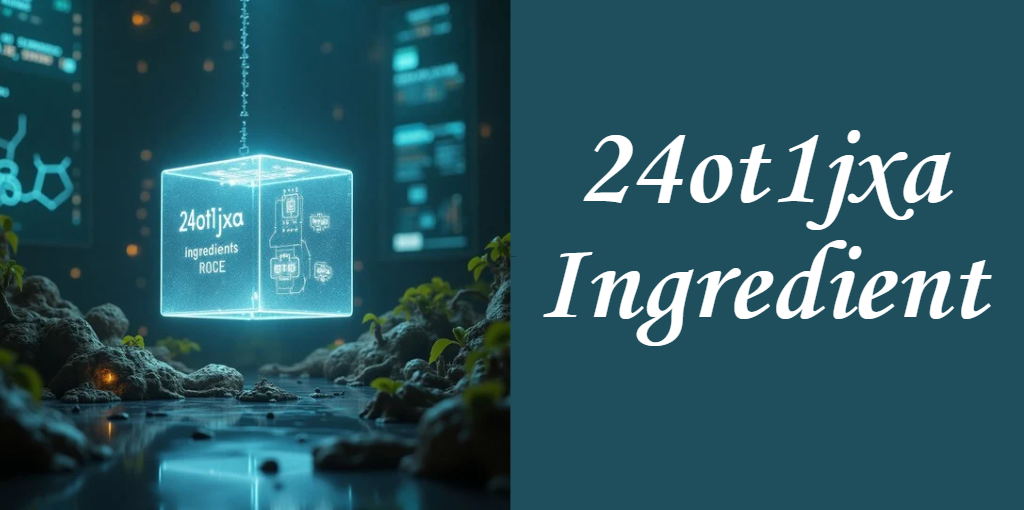Understanding the 24ot1jxa Ingredient: Meaning, Uses, and Myths Explained
The term “24ot1jxa ingredient” can be quite confusing at first glance. At face value, it may seem like a compound found in a chemical product, food additive, or pharmaceutical formulation. However, a closer examination reveals that 24ot1jxa is not an actual chemical or consumable substance.
Rather, it is best understood as a system-generated identifier—a random, alphanumeric code used for tagging, referencing, or tracking purposes in digital environments. Despite this, some sources have mistakenly portrayed it as a physical ingredient, leading to widespread confusion that this guide aims to clear up.
Understanding the nature of such identifiers is critical in a world dominated by digital systems. From user sessions on websites to unique keys in a database, identifiers like 24ot1jxa play a vital role behind the scenes. Misinterpreting these codes can result in unnecessary concern or misinformation, especially when they are taken out of context.
Nature and Origin of the 24ot1jxa Identifier
The 24ot1jxa ingredient is not derived from natural or synthetic compounds. Instead, it belongs to a class of values known as unique identifiers or system tokens. These values are usually generated automatically by computer systems, using a combination of letters and numbers.
The main goal is to create strings that are unique and not easily guessable, ensuring reliable tracking or referencing in software applications.
Such identifiers often appear in the following scenarios:
- Database records (e.g., MongoDB object IDs)
- Web session tokens
- Application programming interfaces (APIs)
- URL shortening services
- Secure login systems
These codes are typically created by random string generation algorithms or hashed functions, ensuring uniqueness and security. Therefore, the phrase “24ot1jxa ingredient” is more accurately described as a “digital identifier” rather than a literal ingredient in a product.
Common Use Cases of the 24ot1jxa Code
The utility of identifiers like 24ot1jxa is widespread, though their use often goes unnoticed by end-users. Below are some of the most common places you might encounter such codes.
- Web Sessions:
When users log into a website, the server generates a unique session ID to track their interaction. 24ot1jxa could represent one such session ID. - Databases:
In systems like MongoDB, each document is tagged with a unique identifier to distinguish it from others. These IDs ensure smooth retrieval and updating of data. - API Requests:
When applications talk to each other via APIs, they often use unique keys or tokens to authenticate communication. These tokens might look like “24ot1jxa”. - Content Delivery Networks (CDNs):
Some URLs served through CDNs include unique codes to prevent caching issues or to manage delivery versions.
Functional Role of the 24ot1jxa Identifier
Although not a traditional “ingredient,” the 24ot1jxa identifier plays key functional roles in technology infrastructure. It contributes to:
Data Integrity
By giving each record or request its own unique reference code, the system can avoid conflicts and ensure that the correct data is accessed or modified.
Security
Using random strings like 24ot1jxa increases security. Unlike sequential numbers, random strings are harder for hackers to predict, thus reducing the risk of unauthorized access.
Scalability
In distributed computing environments, such identifiers enable seamless expansion. Each node can generate unique keys without needing to communicate with a central server.
Here’s a quick comparison table highlighting how 24ot1jxa identifiers enhance functionality:
| Functionality | Purpose | How 24ot1jxa Helps |
|---|---|---|
| Data Tracking | Monitor user or system activity | Assigns unique identifiers |
| Secure Communication | Prevent unauthorized data exchange | Hard-to-guess alphanumeric token |
| Distributed Processing | Work across multiple nodes or services | Guarantees unique key generation |
Advantages of the 24ot1jxa System Token
Although not consumable or biological in nature, the “24ot1jxa ingredient” offers several behind-the-scenes benefits to developers, systems, and users alike:
- Enhanced Security: Random identifiers are harder to predict or replicate.
- Improved Accuracy: Prevents duplication and confusion between different records.
- Cross-Platform Utility: Can be implemented in web, mobile, and cloud environments.
- Low Overhead: Requires minimal resources to generate and manage.
- System Interoperability: Functions seamlessly across APIs and software systems.
These advantages have made the use of identifier codes like 24ot1jxa a standard best practice in the world of information technology.
Addressing Myths: Is 24ot1jxa a Harmful Ingredient?
One of the most misleading aspects surrounding the 24ot1jxa identifier is the mistaken belief that it is a physical or chemical ingredient that might pose health risks. Some unverified websites and social media posts have listed it alongside food additives or pharmaceutical ingredients, raising concerns about toxicity or hormonal disruption.
In reality, there is no credible evidence or scientific data to support the classification of 24ot1jxa as a physical substance. It does not appear in any reputable chemical, food safety, or pharmaceutical databases. Its format—an 8-character alphanumeric string—is consistent with technical usage, not labeling for human consumption.
If you’re worried about something labeled “24ot1jxa ingredient” on a package or online source, it’s best to contact the manufacturer or check with verified ingredient directories. Chances are, the code is being misused or misunderstood.
How to Recognize and Handle the 24ot1jxa Identifier
Recognizing the 24ot1jxa identifier is simple once you know where to look. These strings typically appear in:
- Web application source code
- API headers and responses
- Database entries
- Tracking or logging files
Once identified, the key point is to not modify or expose the identifier unnecessarily. Like passwords or tokens, these strings can carry sensitive associations in certain systems. Tampering with them could break functionality or expose vulnerabilities.
Best Practices:
- Store such identifiers in encrypted databases.
- Avoid logging them in plain text.
- Never share them publicly or in documentation unless required.
- Rotate and expire tokens regularly in security-sensitive environments.
Real-World Examples of 24ot1jxa Usage
Let’s look at some real-life scenarios where identifiers like 24ot1jxa might be used:
| Use Case | Description |
|---|---|
| Web Login System | Used to link a session to a specific user securely |
| Cloud Storage Access | Included in signed URLs to control access to private content |
| IoT Device Communication | Ensures device data is sent to the right system endpoint |
| CDN Cache Bypass | Forces the server to refresh and serve updated content |
These examples make it clear that even though 24ot1jxa isn’t an actual “ingredient,” it’s deeply integrated into the digital landscape we use every day.
Best Practices and Guidelines for Using Identifiers
For developers and technical teams, managing identifiers like 24ot1jxa responsibly is crucial. Below are some recommended practices:
- Generation: Use secure, high-entropy generators (e.g., UUID, crypto-random).
- Length: Opt for strings long enough to minimize collisions (8+ characters).
- Documentation: Label and explain usage clearly in your system design.
- Security Hygiene: Always encrypt identifiers if tied to sensitive data.
Applying these guidelines ensures both system efficiency and robust data security.
Conclusion
The so-called “24ot1jxa ingredient” is not an ingredient in the conventional sense. Rather, it is a system-generated identifier used widely in digital environments to ensure data security, integrity, and functionality. While the term may raise eyebrows or even concern, understanding its origin and use reveals that there’s no reason for alarm.
Whether you’re a developer working with APIs, a user curious about technical terms, or someone who stumbled upon this strange-looking code, knowing the truth about 24ot1jxa can help demystify the invisible but critical components of modern technology. Always remember to treat such identifiers with care, and don’t fall for the myth that it’s a toxic or harmful chemical—it’s simply not.
Additional Posts
Mastering Visual Storytelling with the Ashley Ann Tahigan Storyboard Guide
verything You Need to Know About kep-13228srs08: High-Performance Clutch Disc & More
Is 309-207-7105 a Scam? Full Breakdown, Reports & How to Stay Safe
Mizukando: The Japanese Art of Water-Inspired Living and Mindfulness






